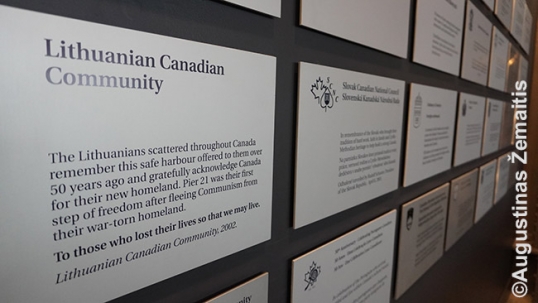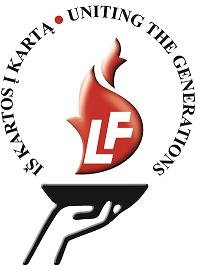Nova Scotia
For centuries, Nova Scotia served as an entrance to Canada, and it has been used by Lithuanians as such.
Halifax, the port of entry of Lithuanian-Candians
Between 1928 and 1971, the main entry port was Halifax or its Pier 21. Possibly the majority of Lithuanians who fled the Soviet Genocide and ended up in Canada passed through here. However, few - if anybody - stayed, continuing on by trains to worksites in remote Canada where they had to work a certain duration of time in order to be allowed to settle in Canada. After that "mandatory job", they typically settled in the major cities (Toronto, Montreal, Hamilton), without even considering Halifax.
With Halifax being the port of entry of so many immigrants and refugees, however, after "Pier 21" was finally outcompeted by air travel, it was transformed into the Canada's top Museum of Immigration. While the museum does its best to represent every single way or "typical experience" for immigrants to Canada, it tends to focus more on the more recent immigrants. While DPs are also well-covered, there are almost no exhibits related to Lithuanians in particular. There is, however, a Lithuanian plaque near the museums entrance. The plaque follows a common design with ~40 other plaques, gifted to the museum by numerous other communities of Canada. Created in 2002, the Lithuanian plaque thanks Canada for providing a safe harbor for the DPs 50+ years ago. It is dedicated "to those who lost their lives so that we may live". The reason for the relative lack of Lithuanian exhibits may also be the fact that Nova Scotia itself lacks a Lithuanian community and the closest major Lithuanian-Canadian community is in Montreal, 1250 km away.

Pier 21 museum
The Pier 21 museum also serves as a point where one is able to search for the data of his/her immigrant forefathers, including Lithuanians.

Lithuanian plaque at Pier 21
Sydney Mines Lithuanian heritage
However, Nova Scotia wasn't always almost without Lithuanians. In fact, the Nova Scotia Lithuanian history has predated the post-WW2 refugees. More than that: Nova Scotia had arguably the oldest Lithuanian-Canadian community of such size. Located in Sydney Mines, it began ~1900 as Lithuanians came there to work in mines and smelter. Many of these immigrants were coming not directly from Lithuania but rather from Scotland, where a Lithuanian immigrant community existed even earlier.
In Sydney Mines, Lithuanians established St. Casimir Society which since 1915 owned a Lithuanian Hall in what is now Pond Street. In 1906, this society had 72 members; however, members consisted solely of adult males, therefore, the actual Lithuanian population was likely multiple times higher.
The Lithuanian "golden age" in Sydney Mines proved to be short-lived, however. As the smelter was closed in 1919, most Lithuanians left, with only 17 families remaining. While the community was somewhat replenished by new immigrants (up to 27 families ~1930), the Lithuanian Hall was closed, later acquired by the city and demolished in 1939.
The only visibly Lithuanian things remaining in Sydney Mines are some Lithuanian gravestones in the town cemeteries at Yorke St (the newer Catholic cemetery) and Shore Rd (older cemetery). Many Lithuanian surnames there are anglicized there. At first, such changes were somewhat predictable (e.g. Liutkevieičus became Liutkus, Bardzevičius became Bardswich) but many families eventually changed their surnames completely (e.g. Rudzevičius became Rogers and Latwaittis - already anglicized from Latvaitis - eventually became Campbell). Luckily, some data about these surname changes, as well as other materials related to Sydney Mines Lithuanians, survive in the local Beaton Archives, mostly donated by the Glinski(s) family which was one of the first Lithuanian families to settle in Sydney Mines.

A Lithuanian grave in Sydney Mines, showing both the original surname (Grinevičius) and the anglicized one (Greene). There is a Lithuanian inscription, albeit incorrectly spelled, "SYEIKA" instead of "SVEIKA".






Leave a comment